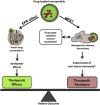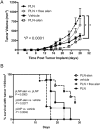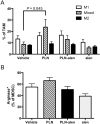Liposome-induced immunosuppression and tumor growth is mediated by macrophages and mitigated by liposome-encapsulated alendronate
- PMID: 29277680
- PMCID: PMC5880305
- DOI: 10.1016/j.jconrel.2017.12.023
Liposome-induced immunosuppression and tumor growth is mediated by macrophages and mitigated by liposome-encapsulated alendronate
Abstract
Liposomal nanoparticles are the most commonly used drug nano-delivery platforms. However, recent reports show that certain pegylated liposomal nanoparticles (PLNs) and polymeric nanoparticles have the potential to enhance tumor growth and inhibit antitumor immunity in murine cancer models. We sought herein to identify the mechanisms and determine whether PLN-associated immunosuppression and tumor growth can be reversed using alendronate, an immune modulatory drug. By conducting in vivo and ex vivo experiments with the immunocompetent TC-1 murine tumor model, we found that macrophages were the primary cells that internalized PLN in the tumor microenvironment and that PLN-induced tumor growth was dependent on macrophages. Treatment with PLN increased immunosuppression as evidenced by increased expression of arginase-1 in CD11b+Gr1+ cells, diminished M1 functionality in macrophages, and globally suppressed T-cell cytokine production. Encapsulating alendronate in PLN reversed these effects on myeloid cells and shifted the profile of multi-cytokine producing T-cells towards an IFNγ+ perforin+ response, suggesting increased cytotoxic functionality. Importantly, we also found that PLN-encapsulated alendronate (PLN-alen), but not free alendronate, abrogated PLN-induced tumor growth and increased progression-free survival. In summary, we have identified a novel mechanism of PLN-induced tumor growth through macrophage polarization and immunosuppression that can be targeted and inactivated to improve the anticancer efficacy of PLN-delivered drugs. Importantly, we also determined that PLN-alen not only reversed protumoral effects of the PLN carrier, but also had moderate antitumor activity. Our findings strongly support the inclusion of immune-responsive tumor models and in-depth immune functional studies in the preclinical drug development paradigm for cancer nanomedicines, and the further development of chemo-immunotherapy strategies to co-deliver alendronate and chemotherapy for the treatment of cancer.
Keywords: Alendronate; Cancer immunology; Immune modulation; Liposome; Nanoparticle.
Copyright © 2017. Published by Elsevier B.V.
Conflict of interest statement
All authors declare that they have no conflicts of interests.
Figures








Similar articles
-
Comparative effects of free doxorubicin, liposome encapsulated doxorubicin and liposome co-encapsulated alendronate and doxorubicin (PLAD) on the tumor immunologic milieu in a mouse fibrosarcoma model.Nanotheranostics. 2022 Sep 1;6(4):451-464. doi: 10.7150/ntno.75045. eCollection 2022. Nanotheranostics. 2022. PMID: 36105861 Free PMC article.
-
Pegylated Liposomal Alendronate Biodistribution, Immune Modulation, and Tumor Growth Inhibition in a Murine Melanoma Model.Biomolecules. 2023 Aug 26;13(9):1309. doi: 10.3390/biom13091309. Biomolecules. 2023. PMID: 37759709 Free PMC article.
-
Liposomal pravastatin inhibits tumor growth by targeting cancer-related inflammation.J Control Release. 2010 Dec 20;148(3):303-10. doi: 10.1016/j.jconrel.2010.09.011. Epub 2010 Sep 30. J Control Release. 2010. PMID: 20869410
-
Repurposing amino-bisphosphonates by liposome formulation for a new role in cancer treatment.Semin Cancer Biol. 2021 Jan;68:175-185. doi: 10.1016/j.semcancer.2019.12.001. Epub 2019 Dec 23. Semin Cancer Biol. 2021. PMID: 31874280 Review.
-
Advanced targeted therapies in cancer: Drug nanocarriers, the future of chemotherapy.Eur J Pharm Biopharm. 2015 Jun;93:52-79. doi: 10.1016/j.ejpb.2015.03.018. Epub 2015 Mar 23. Eur J Pharm Biopharm. 2015. PMID: 25813885 Review.
Cited by
-
Emerging Role of Immunosuppression in Diseases Induced by Micro- and Nano-Particles: Time to Revisit the Exclusive Inflammatory Scenario.Front Immunol. 2018 Nov 19;9:2364. doi: 10.3389/fimmu.2018.02364. eCollection 2018. Front Immunol. 2018. PMID: 30510551 Free PMC article. Review.
-
Mannose Ligands for Mannose Receptor Targeting.Int J Mol Sci. 2024 Jan 23;25(3):1370. doi: 10.3390/ijms25031370. Int J Mol Sci. 2024. PMID: 38338648 Free PMC article. Review.
-
Targeting phosphatidylserine for Cancer therapy: prospects and challenges.Theranostics. 2020 Jul 23;10(20):9214-9229. doi: 10.7150/thno.45125. eCollection 2020. Theranostics. 2020. PMID: 32802188 Free PMC article. Review.
-
Liposome co-encapsulation of anti-cancer agents for pharmacological optimization of nanomedicine-based combination chemotherapy.Cancer Drug Resist. 2021 Jun 19;4(2):463-484. doi: 10.20517/cdr.2020.87. eCollection 2021. Cancer Drug Resist. 2021. PMID: 35582027 Free PMC article.
-
Organic extract of Geodia cydonium induces cell cycle block in human mesothelioma cells.Oncol Lett. 2022 Jun 28;24(2):286. doi: 10.3892/ol.2022.13406. eCollection 2022 Aug. Oncol Lett. 2022. PMID: 35814825 Free PMC article.
References
-
- Nakanishi W, Minami K, Shrestha LK, et al. Bioactive nanocarbon assemblies: nanoarchitectonics and applications. NanoToday. 2014;9:378–394.
-
- Hare JI, Lammers T, Ashford MB, et al. Challenges and strategies in anti-cancer nanomedicine development: an industry perspective. Adv Drug Deliv Rev. 2017;108:25–38. - PubMed
-
- Allen TM, Cullis PR. Liposomal drug delivery systems: from concept to clinical applications. Adv Drug Deliv Rev. 2013;65:36–48. - PubMed
-
- Gabizon AA, Patil Y, La-Beck NM. New insights and evolving role of pegylated liposomal doxorubicin in cancer therapy. Drug Resist Updat. 2016;29:90–106. - PubMed
Publication types
MeSH terms
Substances
Grants and funding
LinkOut - more resources
Full Text Sources
Other Literature Sources
Research Materials

